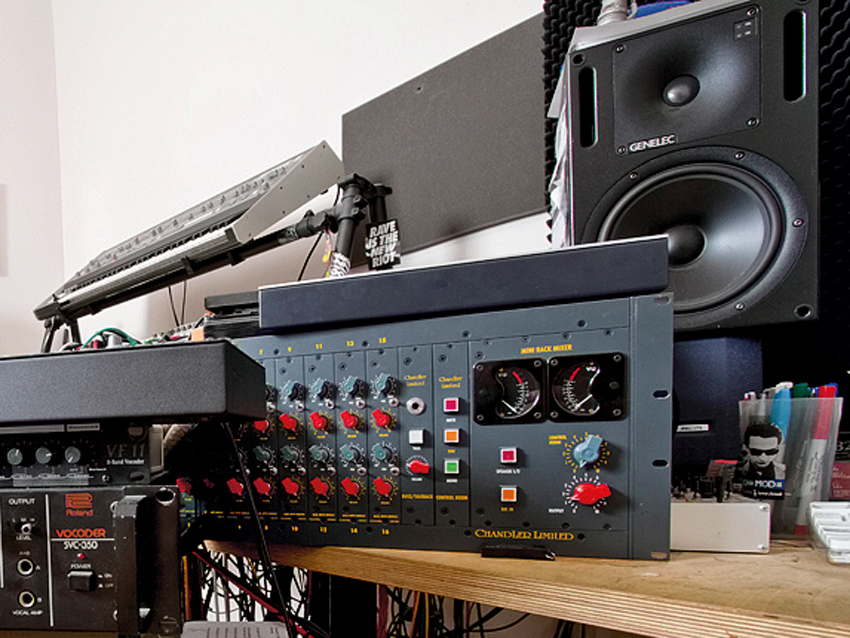In pictures: Boys Noize and his hardware packed studio

Intro
From working with D.I.M. and Tensnake as a teenager in Hamburg, to remixing and producing some of the biggest names in music, Boys Noize, aka Alex Ridha, has smeared his unique sound and style across multiple genres and dancefloors.
His debut album Oi Oi Oi sold close to 100,000 copies and, along with Justice's †, kick-started a new aural assault on clubs around the world. And while every producer and his DAW tried to recreate the sound, Ridha continued to build on his repertoire, working with versatile artists from Erol Alkan, The Black Eyed Peas and Scissor Sisters to Kano, Kelis and Jarvis Cocker. Now, his remixes for Depeche Mode, NERD, Justice, Sebastien Tellier, Röyksopp and many more have been compiled into a Best Of, with everything from dancefloor destroyers to more Pop-style reworkings.
But it's his work with Gonzales on his record Ivory Tower and his stellar production on Spank Rock's Everything is Boring and Everyone is a Fucking Liar that perfectly showcases his versatility and talent across the musical spectrum.
After two years of back and forth, we finally found a date and visited his Berlin studio to find out more about the story, the synths and the samplers behind the noize.

Synths
"At the front is the SH-05 it’s got such a powerful sound. I only got it a couple of months ago and I’ve already done two tracks. The filters are so amazing.”
"There's also a Roland SH-101 with inverted key colours. It has extra filters modded on, I used it on my NERD remix. If I ever want a real good saw sound, this is what I use. It’s fun to trigger it with a drum machine too.”

Allen & Heath Mixwizard 14:4:2
“I never use this to mix, I just wanted something I could record through.
“What I sometimes do is make mirror images of the EQ bands on the left and right channel which is a trick I read about, but that’s all I use the EQ for. I have the effects set up on the busses, but again it’s just for recording.”

Extra Linn chips
“When you make a track with a Linndrum, you can’t really add a big bassline or something. You need to find the right sounds to give the Linndrum its space in the mix.
"Prince had just his voice, a Linndrum and one keyboard and it was enough. No bassline or anything, just nice programming. That’s what I like about it, it’s got such a strong sound.”

Linn chips
“When I bought the Linndrum from Fabian [Feyerabendt] from Toktok [German techno producer duo] it came with a bunch of EPROMs, so I can just switch out any sound.
“It’s tricky though, as the pins are really easy to destroy so you have to be really careful when you’re changing them. It’s great because you can put a bell sound on the snare, for example.
“That’s the kind of thing I like, different sounds that you can mix up with more modern ones that make them a little more special. Sometimes you’ll load in an EPROM and it’s broken and it just makes this crazy sound. The customisation is what makes it really inspiring to work with.”

Monitoring
“I like the Genelec monitors just because I’m used to them. I remember I sat in Switch’s studio in LA and he had the Adams – they sounded good but I thought they were more plastic!
“I have the same feeling with the Funktion One systems. I think you could work with any monitors if you know what you hear and what’s missing.”

Elektron Machinedrum
“For me, Elektron produces the most futuristic machines. The Machinedrum is my favourite by far!
“It’s so easy and fun to program amazing sounds and patterns that just sound different to all the generic electro house and dubstep beats that I really can’t stand.
"For example, I love when the kick drum changes within thetrack, not the sound, more the frequencies or the filter.”

Juno duo
"At the top of the synth rack is the Juno 106 and everyone has one of these. It was one of my first synths. Below that is the Alpha Juno 2,which played the organ sound on Avalanche [with Erol Alkan].
"You can trigger a chord witha single key, so we did basically the entire track on this.It’s totally different to other Junos.”

Rack out
"It wasn't all hardware on the first record,I had the Arturia plug-ins, and maybe a few others here and there. Actually the track Battery was named after the plug-in! Every sound from that track came from the plug-in.
"The bassline on Battery was just a kick drum stretched to become a bass sound and then I recorded it as audio and re-sampled it.”
Future Music is the number one magazine for today's producers. Packed with technique and technology we'll help you make great new music. All-access artist interviews, in-depth gear reviews, essential production tutorials and much more. Every marvellous monthly edition features reliable reviews of the latest and greatest hardware and software technology and techniques, unparalleled advice, in-depth interviews, sensational free samples and so much more to improve the experience and outcome of your music-making.



